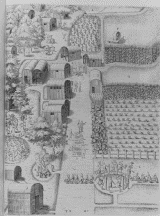
Some North American tribes, like the Iroquois, were organized into large political confederations. Extensive trade networks - sometimes operating over long distances - allowed for the exchange of products such as animal skins, copper, shells, pigments, pottery, and foodstuffs. Housing styles varied from covered wood to multilevel dwellings constructed of stone and mud, and transportable shelters made of poles and animal hides. Many tribes played games such as lacrosse and stickball. Religion was an integral part of daily life, tying them to the land, to other living things, and ot the spirits that animated their world and provided order to social relations.
Secotan Village Showing Space Utilization 
The people of Secotan lived in permanent villages near today's North Carolina Outer Banks. Like the northern Algonquians, they farmed collectively in the growing season and dispersed in family units to hunt during the colder months.
The engraving, based on a drawing made by John White in the 1580s, shows careful management and use of the land. Crops include tobacco and pumpkins, corn in three stages of growth, and sunflowers, while domesticated deer graze in the adjoining woods. The buildings include family units and storehouses for the surplus corn.
A man described as an Indian elder or chief is depicted wearing a copper pendant, similar to the gorget displayed. The Secotan traded with other groups like the powerful Mandoag of the Piedmont area of North Carolina, who acted as middlemen in the copper trade.

 Continue the Voyage with The Mediterranean World or abandon ship and use the
Outline.
Continue the Voyage with The Mediterranean World or abandon ship and use the
Outline.